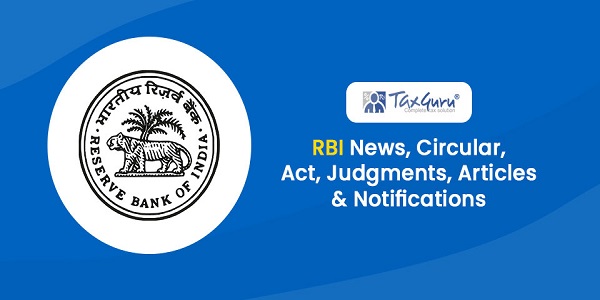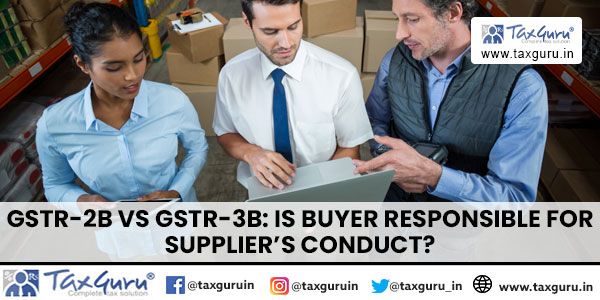Manas Joshi
 One fine morning, my mobile rang and my client asked me “Sir, can I take CENVAT credit on CHA services used for export of goods?” Officers are disallowing our credit”. Since law is very clear, I immediately gave positive reply to my client and discontinued our conversation. Then I thought do we really need interpretation of the definition of “input service” so as to cover services provided by Customs House Agent (CHA) in the definition. With the help of this article, I just want to convey those aspects which are very much clarified by the Central Government as well as Tribunal in relation to availing CENVAT on CHA services used for export of goods.
One fine morning, my mobile rang and my client asked me “Sir, can I take CENVAT credit on CHA services used for export of goods?” Officers are disallowing our credit”. Since law is very clear, I immediately gave positive reply to my client and discontinued our conversation. Then I thought do we really need interpretation of the definition of “input service” so as to cover services provided by Customs House Agent (CHA) in the definition. With the help of this article, I just want to convey those aspects which are very much clarified by the Central Government as well as Tribunal in relation to availing CENVAT on CHA services used for export of goods.
We all are aware that the definition of “input service” has gone through various amendments since past few years which have resulted in lot of litigations. The text of the latest definition of “input service” is reproduced below for your ready reference:
l) “input service” means any service, –
(i) used by a provider of [output service] for providing an output service; or
(ii) used by a manufacturer, whether directly or indirectly, in or in relation to the manufacture of final products and clearance of final products upto the place of removal, and includes services used in relation to modernization, renovation or repairs of a factory, premises of provider of output service or an office relating to such factory or premises, advertisement or sales promotion, market research, storage upto the place of removal, procurement of inputs, accounting, auditing, financing, recruitment and quality control, coaching and training, computer networking, credit rating, share registry, security, business exhibition, legal services, inward transportation of inputs or capital goods and outward transportation upto the place of removal;
but excludes, –
(A) service portion in the execution of a works contract and construction services including service listed under clause (b) of section 66E of the Finance Act (hereinafter referred as specified services) in so far as they are used for –
(a) construction or execution of works contract of a building or a civil structure or a part thereof; or
(b) laying of foundation or making of structures for support of capital goods, except for the provision of one or more of the specified services; or
(B) services provided by way of renting of a motor vehicle], in so far as they relate to a motor vehicle which is not a capital goods; or
(BA) service of general insurance business, servicing, repair and maintenance, in so far as they relate to a motor vehicle which is not a capital goods, except when used by –
(a) a manufacturer of a motor vehicle in respect of a motor vehicle manufactured by such person; or
(b) an insurance company in respect of a motor vehicle insured or reinsured by such person; or]
(c) such as those provided in relation to outdoor catering, beauty treatment, health services, cosmetic and plastic surgery, membership of a club, health and fitness centre, life insurance, health insurance and travel benefits extended to employees on vacation such as Leave or Home Travel Concession, when such services are used primarily for personal use or consumption of any employee
It can be seen that the above definition is divided into three parts. The first part covers all such services which have direct or indirect co-relation with the manufacture of final goods. The second part starts with the word “and includes” and therefore, this is the inclusive part of the definition till exclusion part. This second part not only covers the services which are specifically mentioned but also those services which are not specifically mentioned and which are not specifically covered in the exclusion part of the definition (this is where most of the litigations are going on and expecting much more in future). Lastly, the third part of the definition, starting with the word “but excludes” relates with the exclusion part. It can be clearly seen from the definition that the exclusion list is specific and not “inclusive”. Thus, prima facie it can be concluded that an assessee can avail CENVAT credit of all such services which are not specifically excluded from the definition. It is important to note that the service provided by CHA is nowhere mentioned in the exclusive part of the definition and therefore, CENVAT credit on CHA service should be allowed.
IN CASE OF EXPORT, PORT IS PLACE OF REMOVAL
Further to our discussion, I wish to bring your attention to the last sentence of the “inclusive part” which says that services related to outward transportation of goods upto the place of removal. The term “place of removal” is not defined under the Cenvat Credit Rules, 2004 and therefore, we need to refer the definition of “place of removal” given under Section 4(3)(C) of the Central Excise Act, 1944. The text of the definition is reproduced below for your ready reference:
“place of removal” means –
(i) a factory or any other place or premises of production or manufacture of the excisable goods;
(ii) a warehouse or any other place or premises wherein the excisable goods have been permitted to be deposited without payment of duty;
(iii) a depot, premises of a consignment agent or any other place or premises from where the excisable goods are to be sold after their clearance from the factory;
from where such goods are removed;
In normal practice, the manufacturers export goods on FOB basis i.e. Free on Board basis. In such cases, ownership of such export goods belongs to the manufacturer-exporter until such manufacturer-exporter hand over documents related to such export good to the shipping lines. In other words, it can be said that ownership of export goods get transferred to the foreign customer upon transfer of documents of title to shipping lines at Port and thus, “Port” is the place from where export goods are to be sold. As seen in the definition of the “place of removal”, the third point of the definition clearly says that “place of removal” is any place from where the excisable goods are to be sold after their clearance from the factory and thus, it is clear that in case of export of manufactured goods, “Port” is the “place of removal”. Thus, CHA service availed for export of goods is specifically included in the definition of “input service”.
In this connection, reliance can be place on the below decisions of the Hon’ble Tribunal wherein it is held that in case of export of manufactured goods, port is the place of removal and therefore, CENVAT credit of service tax paid on CHA service is admissible:
a) CCE, Hyderabad-IV v/s Pokarna Ltd. – 2013 (292) E.L.T. 316 (Tri. – Bang.)
b) CCE, Rajkot v. Rolex Rings P. Ltd. – 2008 (230) E.L.T. 569 (Tri.-Ahmd.)
c) Adani Pharmachem (P.) Ltd. v. CCE, 2008 (232) ELT 804 (Tri. – Ahmd.)
d) Meghachem Industries v/s CCE, Ahmedabad – 2011 (23) S.T.R. 472 (Tri. – Ahmd.)
e) JK Tyre & Industries LTD. v/s CCE, Mysore – 2010 (18) S.T.R. 637 (Tri. – Bang.)
CBE&C CLARIFIES THAT PORT IS PLACE OF REMOVAL IN CASE OF EXPRT
Further, I wish to bring your attention to para no. 8.2 of the Circular F. No. 137/85/2007-CX.4 wherein the CBE&C has also clarified that CENVAT credit of service tax paid on the transportation of goods upto such place of sale would be admissible if it is established that sale has actually taken place at the place of customer (it is also useful in case of credit on outward transportation of GTA service). In case of export goods, ownership of such goods remained with the manufacturer-exporter till port area and it gets transferred at the Port upon hand over of documents of title to export goods and therefore, based on clarification issued by the CBE&C, CENVAT credit of service tax paid on CHA service for export of goods is admissible.
























Sir,
We have only export business and doing our export activities through CHA.
Our CHA charge service tax in their bills, can we take input of such service tax amounts.
Please guide us
Hi Manas
can you clarify my doubt
i provide export service thus i dont charge service tax on it (all conditions adhered to).
problem arises when i use domestic input service for such export services, i am charged with service tax. it becomes additional burden on me.
what is my way out for it.
1) can i adjust it against other taxable services
or
2) claim refund / rebate of it
Hi Manas,
well said with case laws.
CHA clears the goods on behalf of the Importer or exporter and raise invoice to respective customers.Invoice contains both taxable and reimbursable expenses supported by respective documents. All reimbursable bills will contain service tax How come the service receiver can avail the service tax input and what is basically required in relevant reimbursable invoices(In what name the invoice should be-in fvr service receiver or CHA). can u explain.
Dear all,
Pls explain that, why department issue NF No 17/2009 or 41/2012 refund for service tax paid on service used for Export. if cenvat credit eligible as per CCR 2004,
It means, either assessee has been availed cenvat credit on said service or a filed refund. or
Department intentionally prohibited that the said credit not admissible under CCR 2004.
Nice analysis
Manas,
Really nice explanation. Good to read!
Mr Joshi made beautiful analysis of input service definition with the help of case laws so as to convince a point that credit on CHA service is admissible. I would like to add another point that supports his view. Take the case of Notification No.52/2011-ST dt 30.12.2011,which of course is superseded by Notification No.41/2012-ST now. The Notification used to grant exemption of service tax paid on CHA service (Sl.No.11 of the Notification as many other services specified in addition to CHA service)by way of refund. One of the conditions stipulated for grant of refund , was mentioned in first proviso that no CENVAT credit of service tax paid paid on the specified services used for export of the said goods has been taken under CENVAT CREDIT RULES,2004. In other words, Government intention is to allow credit on CHA service under Cenvat Credit Rules,2004. However, if the credit is taken on CHA service,refund of Service tax paid would not be eligible. The Notification No.41/2012-ST has similar conditions though, it does not mention the list of services on which refund of credit is granted.
Good explanation
in this above view is department denied the cenvat credit then you may be file claim of refund on export service as Ntf.11/2005 S.T.DATED 19.04.2005
where service tax has allready been paid on export of service please refer Service Tax Notification No.12/2005 dt. 19.04.2005
Tnx/rgds
MEENA & L.C.
[SHIPPING LINES & LEGAL CONSULTANCY]
EXIM,EXCISE,SERVICE TAX,DGFT & SEZ
GANDHIDHAM-GUJARAT-370201
L.C.9725438120